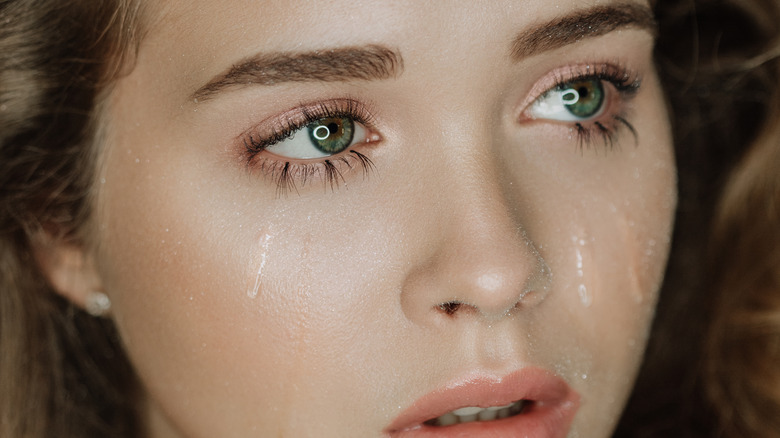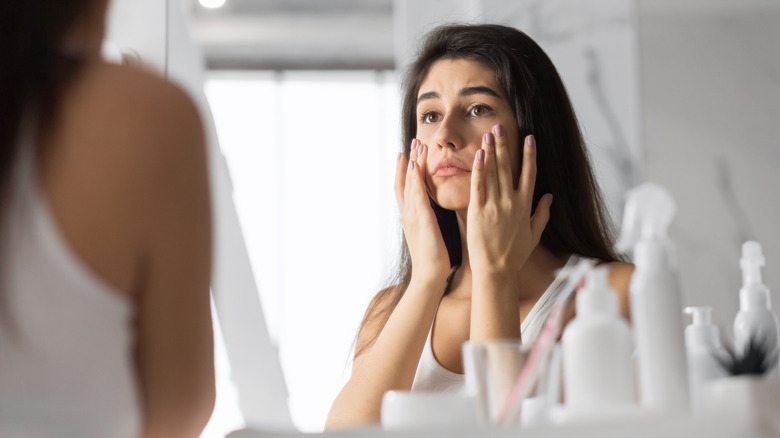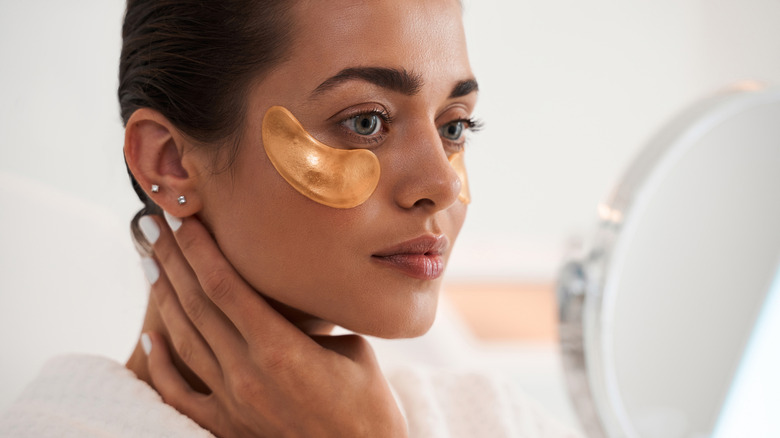Is Crying Good Or Bad For Your Skin?
Crying — whether happy tears, or sad — has a lot of emotional and mental benefits. While it may not feel that wonderful in the moment, especially if the tears are triggered by a traumatic or upsetting situation, crying can relieve pain and tension, reduce stress hormones, and inevitably boost your mood (via MedicalNewsToday). Plus, shedding tears is considered a self-soothing practice that stimulates that weightless, relaxed feeling we all experience after a good cry sesh.
In fact, crying has such a profound connection to relieving stress and boosting mental health that some cities in Japan hold monthly cry meetings called rui-katsu (which translates to "tear-seeking"), encouraging participants to let it all out through tear-jerking poetry, films, and other emotionally-charged works of art (via The Atlantic). Unfortunately, though, there's yet to be any evidence that crying can stimulate eyelash growth.
When you find yourself bawling your eyes out, we know the state of your skin may not be at the forefront of your mind. But after you wipe away those tears and look in the mirror, you may notice those puffy eyes staring back at you and wonder: Is crying good or bad for your skin?
Crying can be both good and bad for your skin
Let's start by discussing what happens to your face when you cry, which is best described by board-certified dermatologist Marie Hayag, M.D. "When we cry, our lacrimal glands are supported by tear fluid, which comes from an increase of blood flow to our eyes, causing bloodshot eyes and pupil dilation," she told Yahoo! News. "The salt in tears leads to water retention and swelling around our eyes. More blood is also flowing to the whole facial region, causing a strained, red, puffy face."
And when you cry, your body releases watery tears that are jam-packed with electrolytes (via Healthline). What happens when you lose electrolytes? You get dehydrated — and your skin will show it, becoming dry and irritated (especially if you already have dry skin to begin with). And even though your instinct may be to wipe your tears away with your hands, tissues, or the sleeve of your shirt, that skin is only becoming more inflamed from the rubbing.
However, if you have oily skin, crying may keep acne at bay, thanks to its salty composition. "... for oily skin types, the salt in tears can likely benefit the skin by drying out excess oil and potentially killing bacteria on the skin that can cause acne," Pennsylvania-based board-certified dermatologist Erum Ilyas, M.D., told Shape. Plus, when you release tears, you are simultaneously releasing stress, which can be helpful for those who tend to develop acne breakouts brought on by heightened stress levels.
How to (physically) bounce back after crying
Although tears tend to dehydrate the skin and cause mild irritation, the good news is it's only temporary. With the proper post-cry steps, you can combat and restore your skin. Since electrolytes were lost, it's no surprise that the best thing you can do is drink water. And don't forget to reach for moisturizing skincare to treat that thirsty skin! Use calming face wash and avoid cleansers with harsh chemicals, like sulfates, that may disturb the skin even more.
To treat the inevitable puffy under eyes, cold compresses are your best friend. According to Shape, cold compresses are a god-send when treating inflammation by tightening the blood vessels in your skin. So, you may want to place a freezing-cold washcloth on your face to lessen the swelling. Put that ice roller to good use, and invest in some under-eye masks to minimize those dark circles and puffiness. Once that eye mask is removed, apply an under-eye cream for maximum results. And if you feel the tears coming, grab a tissue and blot them away before they run down your face. We know it's hard to catch them all once they start streaming, but a girl can try!


